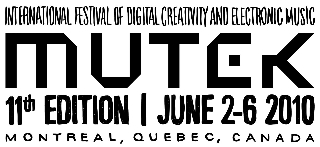
Montreal in June is an explosion of festivals. MUTEK, the annual festival of “digital creativity and electronic music,” is one of the most intriguing. The focus of the festival, now in its eleventh year, is on live experimental electronic music. This year's MUTEK sported an impressive roster -- electronic supergroups like Matmos and Mouse on Mars; cutting-edge UK dubstep producers such as Ikonika; and notable German DJs like Dixon, Henrik Schwarz, and DJ Koze.
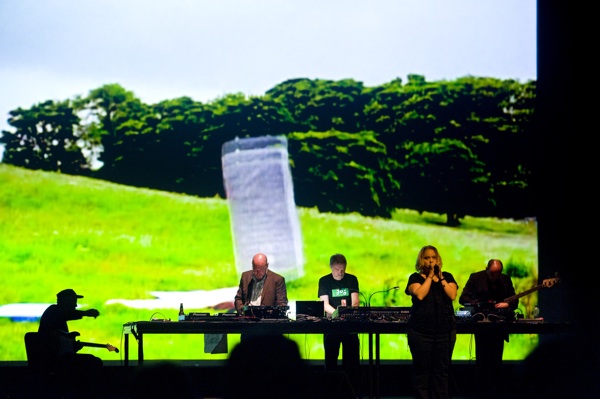
One of the most anticipated live sets at MUTEK was a rare performance by the trailblazing British group Nurse with Wound. Nurse with Wound is a difficult act to pin down. The band, a revolving cast of characters helmed by the shadowy Steven Stapleton, has been in existence, in some form or another, since 1978. Some call Nurse with Wound "industrial music," but that's a bit of a misnomer. The band does bear some similarities with crusading British bands like Throbbing Gristle, Coil, and Current 93, but their music -- disorienting sound collages, ambient drones, tape edits, noise -- is defiantly anti-genre. Perhaps a better way to describe Nurse with Wound is through their artistic inspirations -- Dada sound poetry and French musique concrète, Futurist rhetoric and Surrealist cinema. The band's third album, released in 1980, was titled "Merzbild Schwet," a reference to Kurt Schwitters and his "Merz" philosophy and series of works; Side One was titled "Futurismo"; Side Two was titled "Dada." (Interestingly, many other musicians of the time were referencing Kurt Schwitters -- Faust, Brian Eno, and later the Japanese noise artist Merzbow -- the "Merzbau" being one of Schwitters' most famous works.)
Nurse with Wound played a haunting set in a dark auditorium against a sinister black-and-white film backdrop. Ambient drones were punctuated with harsh, sudden crashes -- reminiscent of the sound of a door slamming shut, again and again. The series of images onscreen became increasingly sinister and disjointed as the performance progressed: A person slices open a fish. A man and a woman kiss; the man's face becomes grotesque. Someone gnaws on a slab of meat. Various things get set on fire -- buildings, people. A woman strokes a black cat. A plate of half-eaten food appears. Chairs fall from the sky, reminiscent of the tornado scene in Wizard of Oz.
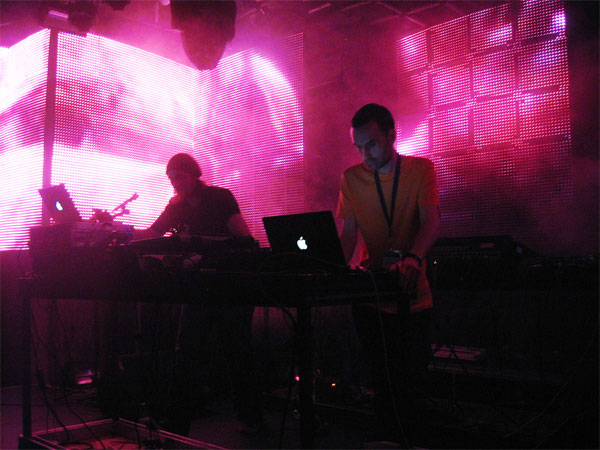
Nurse with Wound's queasy, uneasy vibe was one that would be echoed throughout the music of the festival. Demdike Stare, an eclectic duo from the UK that combine dubstep vibes with drone, dub techno and a record collection that goes deep into African and Arabic music, played an absorbing set in the cavernous environs of Montreal's Société des arts technologiques (SAT) that could best be described as trance-like, almost ritualistic. A few doors down, the much buzzed-about UK producer Actress -- a.k.a. Darren Cunningham -- played a transfixing live set that was sadly hampered by a lack of an engaging stage presence. One of the difficult things about MUTEK -- with its emphasis on live electronic music, as opposed to DJ sets -- is that many of the performers play live sets with laptops, and five straight days of watching laptop-based electronic music can get tiresome. There are many ways to get around the tyranny of the laptop, of course. Several of the performers at MUTEK incorporate other hardware -- samplers and so on -- with laptops, making it more of a dynamic experience; some dress in crazy outfits (the New York group Konque donned white space suits and plastic face masks); some use films, light shows, or other visual backdrops; some just dance wildly behind their glowing Macbook screens. Actress just stood there, which was too bad, because his intriguingly low-fi dance music is beautiful -- hazy, eerie, and smeared with memory, like dubstep filtered through dust and refracted through the lens of early '90s rave.

One of the most memorable parts of MUTEK is traditionally the Piknik Elektronik, a daytime dance party in Montreal's Parc Jean-Drapeau that takes place under an enormous Alexander Calder sculpture (L'Homme, built for Montreal's Expo in 1967.) This year, an epic rainstorm made the Piknik difficult to manage, but the crowd soldiered on, dancing in ponchos and umbrellas to the sounds of Minilogue and DJ Koze. You never know quite what to expect from DJ Koze, which is part of the reason why he's one of the most interesting DJs and producers in Germany at the moment. Over the years, Koze has been a hip-hop DJ, a producer of epic techno tracks, and the architect of hilarious stunts (he once did an over-the-top cover of "We are the World," in which he sang all the voices himself.) In Detroit a week earlier, Koze had played a rocking techno set; here in Montreal, in the pouring rain, he was playing big, jazzy house records, and disco.
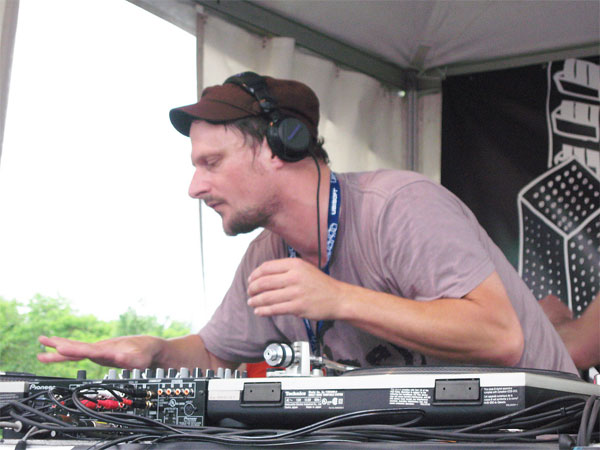
Many other acts at MUTEK --- there are far too many to list here -- were spellbinding. Some didn't get the audience they deserved -- Move D, aka the artist David Moufang, played an achingly gorgeous set early on Saturday night when people were still gathering, and the volume levels didn't seem high enough. The Moritz von Oswald Trio -- an avant-garde supergroup consisting of Moritz von Oswald (best known for his work as part of the legendary German techno imprint Basic Channel), Sasu Ripatti (better known as Vladislav Delay), and Max Loderbauer -- also weren't turned up loud enough; their subtle, finely-wrought sounds were drowned out by the noise of a hundred conversations.
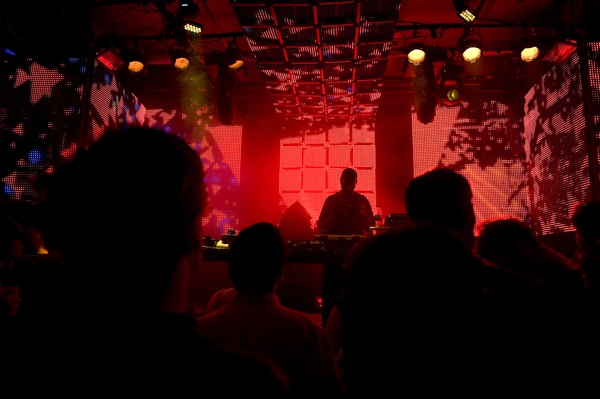
Some of the most enjoyable moments at MUTEK were less about pushing the limits of electronic music and more about moving the dancefloor. The Berlin DJs and producers Henrik Schwarz and Dixon played strong late-night sets, soulful and lyrical, and heavy on house. The Detroit legend Theo Parrish closed MUTEK late on Sunday night with an impressive DJ set, also heavy on house. Parrish went all over the map, playing everything from Steve Reich's "Electric Counterpoint - Fast (Movement 3)" to The Police to the little-heard 1986 Chicago house gem "Beyond the Clouds," an ethereal eight-minute-long Mr. Fingers track that was originally the B-side of the classic house anthem "Can You Feel It." Parrish dropped in several of his own house tracks along the way, leisurely winding his way through an entire alternate history of dance music of the course of a few hours. It was a beautiful end to a festival that has become an institution -- not just for Montreal, but for the world of electronic music.
Geeta Dayal is the author of Another Green World (Continuum, 2009), a new book on Brian Eno. She has written over 150 articles and reviews for major publications, including Bookforum, The Village Voice, The New York Times, The International Herald-Tribune, Wired, The Wire, Print, I.D., and many more. She has taught several courses as a lecturer in new media and journalism at the University of California - Berkeley, Fordham University, and the State University of New York. She studied cognitive neuroscience and film at M.I.T. and journalism at Columbia. You can find more of her work on her blog, The Original Soundtrack.


What I wouldn't have given to be there! Any comments from anyone who DID attend? I'd love to hear about it…
Kim
htp://www.theblogmaker.com
Does anyone know who did the films during the Nurse with Wound show? Or know who I can talk to to find out? I'm desparate and want to see these films again!